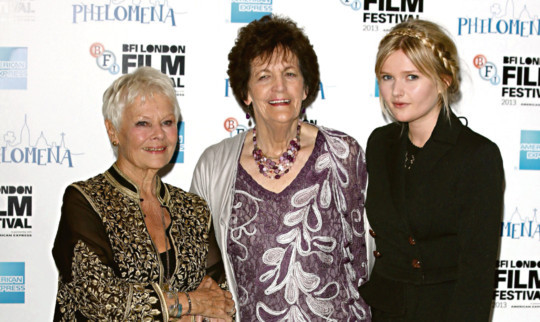
For 50 years, Philomena Lee kept a secret now the world will hear it.
The retired nurse lives a quiet life, close to her daughter Jane, son Kevin and her grandchildren. Keeping family nearby is important to Philomena, as her history is one of loss, abandonment and forced adoption.
Her mum died when she was six so she and her two sisters were split from their three brothers and sent by their father to a convent.
Philomena emerged in 1952 as a naive 18-year-old and went to live with an aunt in Limerick. After a liaison with a man at a country fair she fell pregnant, was ostracised by her family and sent to a convent.
She was made to work in the laundry along with other “fallen women” and only allowed access to her young son, Anthony, for an hour a day. When he was three, a week before Christmas, Anthony was taken from the convent against her will. The nuns had agreed to sell him for adoption to an American family.
Philomena left the convent soon after and made a new life for herself in England, where she still lives, marrying a fellow nurse and having two more children. She never told them about their half-brother until getting emotional on the night of his 50th birthday.
Now the search for Anthony has been turned into a film, starring Dame Judi Dench.
“When I heard Judi Dench was interested in playing me, I was thrilled,” says Philomena, now 80.
The journey from secret revelation to possible Oscar nomination (director Stephen Frears describes Dame Judi’s performance as “the best of her life”) began when a friend put Philomena’s daughter Jane in contact with journalist Martin Sixsmith.
At a loose end, having just been forced to resign from his position as one of Tony Blair’s spin doctors, he reluctantly (at first) took up the story.
“I’ve done many things in my life worked for the government, worked for the BBC, been a historian this was something I hadn’t done before, a human interest story,” he explains.
Despite a refusal by the Sisters of the Sacred Hearts of Jesus and Mary to help (even though they knew exactly where Anthony was), Martin discovered he’d been adopted by a professional couple from Missouri. His name had been changed to Michael Hess and he’d become a successful lawyer and member of the Republican party.
He’d been an advisor to Ronald Reagan’s administration and, when George Bush Senior became President, was appointed as his chief legal counsel. But Michael always knew he’d been adopted and, from 1977, had made frequent trips to Ireland, hoping to find his birth mother.
To give away what happened next would spoil the film but, angry at her treatment at the hands of the Catholic Church, Martin turned Philomena’s story into a book, The Lost Child Of Philomena Lee, which attracted the interest of Steve Coogan.
Lapsed Catholic Coogan was looking for a serious movie project. He wrote a script with Jeff Pope, who won a Bafta in 2007 for TV drama See No Evil: The Moors Murders, and cast himself in Sixsmith’s role. Then he contacted Judi Dench.
“He read it to me and I immediately wanted to do it,” says Dame Judi.
“The only thing that concerned me was playing a real-life person, and somebody who is still alive. I felt the responsibility to tell Philomena’s story very heavily on my shoulders.”
Philomena is at cinemas from Friday.

Enjoy the convenience of having The Sunday Post delivered as a digital ePaper straight to your smartphone, tablet or computer.
Subscribe for only £5.49 a month and enjoy all the benefits of the printed paper as a digital replica.
Subscribe